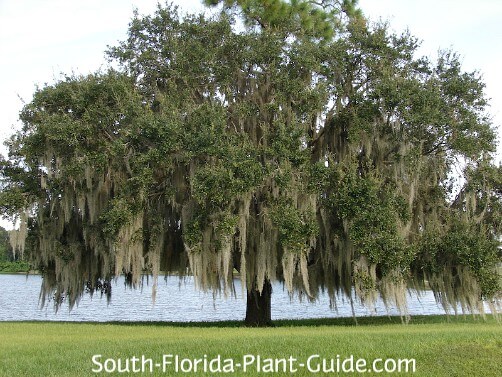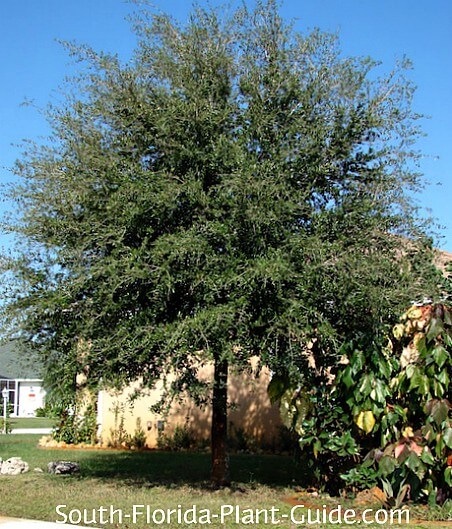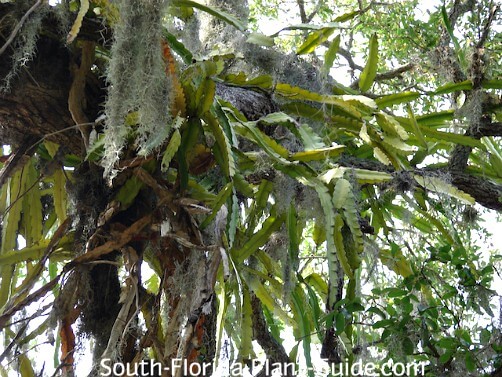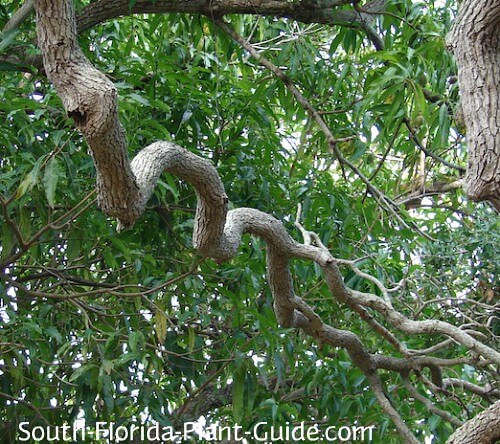Live Oak Tree
Quercus virginiana
The ultimate in trees for shade, the live oak tree has been immortalized as the classic symbol of the South - big, beautiful, and romantically draped in Spanish moss.

No plant has quite the "presence" of this magnificent tree. It can survive for centuries. It provides shelter and food for birds and squirrels. It even adds monetary value to your home.
A single live oak can add up to $30,000 value to a property, according to University of Florida botanist Francis Putz. He also states having one planted near a house can help save it from hurricane damage by acting as a windbreak. These trees are very wind-resistant, even during hurricanes.
These oaks are some of the most commonly planted large shade trees in Florida.
One live oak tree can grow a broad-spreading canopy of arching, horizontal branches that can cover half a football field - including the sidelines and some of the stands.

Beautiful at every stage of its long life, a live oak's silvery gray branches on young trees mature to unbelievably long, thick ones from an immense trunk.
The wood itself is dense and heavy, ideal for everything from firewood to ship building.
During the War of 1812, cannon balls bounced off the sides of the USS Constitution, giving the ship the nickname of "Old Ironsides." The ship was built from live oak wood.
In fact the Navy used to grow its own forests of live oaks.
Sometimes called Southern live oak, it's a wonderful wildlife habitat, though it takes quite a while to begin producing acorns...usually 20 years or more.
Many people complain of live oaks as being very messy trees. They're right, once the tree is mature.
It drops leaves that are small and hard to rake. Spanish moss is decorative on the tree but falls in big furball clumps onto the ground. The tiny yellow flowers in spring can cover everything beneath the tree with a light dusting of yellow. Some acorns sprout - often planted by squirrels burying food for "later" - and are so well-rooted they can be difficult to pull out.
But young trees are much less messy than older ones - and the work involved is really a small price to pay for the shade, character, landscape beauty and value, not to mention the protection from winds that oaks provide.
These trees support more than just wildlife...they also are home to epiphytes (air plants) besides Spanish moss - things like night-blooming cereus (pictured below) and staghorn fern.

Plant specs
A live oak tree is a moderate grower to 60 feet (though not likely in our lifetime) with a very wide-spreading crown.
It needs full sun and room to spread its wings, as well as a well-drained planting location.
Oaks are cold hardy, fine in any Florida planting zone. They're considered semi-deciduous, meaning they push out old growth to make way for new...but we would call it evergreen since it never goes completely or even noticeably bare.
They are considered "deer-resistant" - though there are no guarantees.
Plant care
Add top soil to the hole when you plant.
Trimming is unnecessary for a young live oak tree but watering is. These trees must have regular irrigation to grow strong root systems that will support this large a tree.
Fertilize 3 times a year - in spring, summer and autumn - with a top quality granular fertilizer.

Plant spacing
Plant at least 15 feet from the house, more (and then some) if you can.
Come away from a walk or drive 10 feet or more so roots don't cause problems.
Avoid placing near other big trees that will shade it.
Do not plant too near an uncaged pool due to leaf litter.
Landscape uses for live oak tree
- single yard specimen
- along the property line
- in multiples to create a woodland from a large, plain yard
GOOD SNOWBIRD PLANT? YES
COMPANION PLANT SUGGESTIONS: Don't plant under a young oak tree and keep turf grass from growing right up to the trunk. Once the tree has matured, you can tuck bromeliads around the base. Nearby plants that love the dappled shade of the oak's big canopy might include peace lily, fern, croton, chenille plant, ginger, dwarf azalea, golden shrimp plant, and elephant ears.
Other trees you might like: Mahogany, Gumbo Limbo
- Home ›
- Shade Trees ›
- Live Oak
Take a break!
The ultimate guide to low-maintenance plants
and landscaping!
An ebook by
Chase Landre
author of
South-Florida-Plant-Guide.com
Learn more!
Get a greener thumb!
Want to learn more about South Florida planting, watering, fertilizing and dealing with weeds and pests?
See our Gardening How-To section for answers!
Get instant curb appeal!
An ebook by
Chase Landre
author of
South-Florida-Plant-Guide.com
Learn how to get instant curb appeal with fast growing plants and landscaping techniques!



